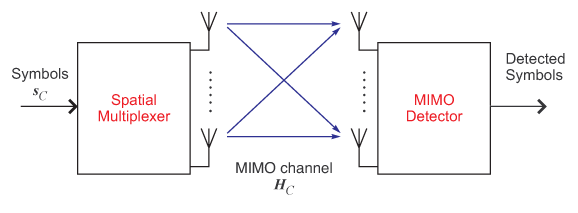MIMO Problem Statement
 |
We consider a standard, but widely encountered MIMO system model:

where
 received signal vector;
received signal vector; transmitted signal vector;
transmitted signal vector; receive dimension;
receive dimension; number of transmitted symbols;
number of transmitted symbols; noise;
noise; symbol constellation set (e.g. QPSK, 16-QAM).
symbol constellation set (e.g. QPSK, 16-QAM).
The signal model covers a wide variety of detection problems in multi-user communication and multi-antennas communication. For instance, in a multi-antenna point-to-point wireless link with spatial multiplexing (or V-BLAST) being the transmit scheme,  physically represents a multi-antenna channel where
physically represents a multi-antenna channel where  and
and  are the number of transmit and receive antennas, respectively. Moreover, in a multiuser CDMA system, we have each column of
are the number of transmit and receive antennas, respectively. Moreover, in a multiuser CDMA system, we have each column of  being a signature sequence of a particular user (i.e. the spreading code sequence) and
being a signature sequence of a particular user (i.e. the spreading code sequence) and  is the number of users. The standard signal model above can also be applied to space-time coding, space-frequency coding, combinations of multiuser and MIMO systems, etc.
is the number of users. The standard signal model above can also be applied to space-time coding, space-frequency coding, combinations of multiuser and MIMO systems, etc.
The maximum-likelihood (ML) detection problem can be stated as

ML detection is optimal in yielding the minimum error probability of detecting  . However, the ML detection problem is hard to solve when
. However, the ML detection problem is hard to solve when  and/or the constellation size
and/or the constellation size  is large. In order to approximate the ML problem within manageable complexity, the ML problem has been handled by approaches such as sphere decoders, semidefinite relaxation detectors, lattice-reduction-aided detectors, etc.
is large. In order to approximate the ML problem within manageable complexity, the ML problem has been handled by approaches such as sphere decoders, semidefinite relaxation detectors, lattice-reduction-aided detectors, etc.